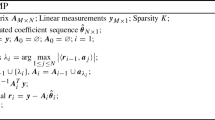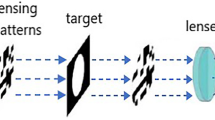Abstract
In today’s digital world, data transmission and storage is becoming a massive problem. This is because the data produced by various sensors worldwide is outstripping the ability to store them. Pre-processing the entire data before transmission is the best solution for reducing the storage issue. ‘Compressed sensing’(CS) is a pre-processing technique that exploits the sparsity of the signal for sampling the data. Since most of the natural signals are sparse, CS allows sampling at a rate lesser than that required in Nyquist sampling theorem. However, in conventional CS, sampling is done for the entire image at once which increases processing time and reduces visual quality. In block compressed sensing (BCS), blocks of the images are processed simultaneously which increases processing speed and decreases the processing time. To improve the quality of the reconstructed signal, a variant of BCS, Adaptive block compressed sensing (ABCS) is used. This review paper studies the advantages, challenges and applications of applying ABCS for image compression.




Similar content being viewed by others
References
Amir A, Zuk O (2011) Bacterial community reconstruction using compressed sensing. J. Comput. Biol. 18(11):1723–1741
Bajwa W, Haupt J, Raz G, Wright SJ, Nowak R (2007) Toeplitz-structured compressed sensing matrices in: IEEE 14th Workshop on Statistical, Signal Processing, pp. 294–298.
Baraniuk Richard G (2007) Compressive sensing. IEEE signal processing magazine 24(4):118–121
Baraniuk Richard G, Candes E, Elad M, Ma Y (2010) Applications of sparse representation and compressive sensing, Proceedings of the IEEE 98, no. 6, pp. 906–909
Bhateja AK, Sharma S, Chaudhury S, Agrawal N (2016) Iris recognition based on sparse representation and k-nearest subspace with genetic algorithm. Pattern Recognit Lett 73:13–18
Binev P, Dahmen W, DeVore R, Lamby P, Savu D, Sharpley R (2012) Compressed sensing and electron microscopy." In Modeling Nanoscale Imaging in Electron Microscopy, pp. 73–126
Bing Han A, Feng Wub, Dapeng (2010) Image representation by compressive sensing for wireless sensor networks’, J Vis Commun Image R pp.325–333
Candès E, Romberg J (2004) Practical signal recovery from random projections, in: Wavelet Applications in Signal and Image Processing XI, Proc. SPIE Conf., pp. 5914–5931
Candes EJ, Wakin MB (2008) An introduction to compressive sampling. IEEE Signal Process Mag 25(2):21–30
Canh TN, Dinh KQ, Jeon B (2014) Edge-preserving nonlocal weighting scheme for total variation based compressive sensing recovery, in Proceedings of the IEEE International Conference on Multimedia and Expo (ICME ‘14), pp. 1–5
Dai W, Sheikh MA, Milenkovic O, Baraniuk RG (2008) Compressive sensing DNA microarrays. EURASIP J Bioinform Syst Biol 2009:162824
Deng, Lin W, Lee B-S, Lau CT “Robust image compression based on compressive sensing” in: Proc. Int. Conf. Multimedia & Expo (ICME), pp. 462–467
Donoho DL (2006) Compressed sensing. IEEE Trans Inf Theory 52(4):1289–1306
Donoho DL, Tsaig Y, Drori I, Starck J-L (2012) Sparse solution of underdetermined systems of linear equations by stagewise orthogonal matching pursuit. IEEE Trans Inf Theory 58(2):1094–1121
Duarte MF, Davenport MA, Takhar D, Laska JN, Sun T, Kelly KF, Baraniuk RG (2008) Single-pixel imaging via compressive sampling. IEEE signal processing magazine 25(2):83–91
Duda RO, Hart PE, Stork DG (2000) Pattern classification. Wiley, New York
Fornasier M, Rauhut H (2011) Compressive sensing, Springer Handbook of mathematical methods in imaging, pp. 187–228
Francesco M, Massimo V (2009) An efficient lossless compression algorithm for tiny nodes of monitoring wireless sensor networks. Comput J 52(8):969–987
Gan L (2007) Block compressed sensing of natural images. In Proceedings of the international conference on digital signal processing, pp. 403–406
Gao Z, Xiong C, Ding L, Zhou C (2013) Image representation using block compressive sensing for compression applications. Journal of Visual Communication and Image Representation 24(7):885–894
Kang B, Zhu W-P (2015) Robust moving object detection using compressed sensing. IET Image Process. 9(9):811–819
Lee D-U (2009) Hyungjin Kim and Mohammad Rahimi Estrin “energy-efficient image compression for resource-constrained platforms”. IEEE Transactions on Image Processing, volume 18(9):2100–2113
Li R, Duan X, Guo X, He W, Lv Y (2017) Adaptive compressive sensing of images using spatial entropy. Computational intelligence and neuroscience 2017:1–9
Li, R, Duan X, Lv Y (2018) Adaptive compressive sensing of images using error between blocks. International Journal of Distributed Sensor Networks 14, no. 6
Li R, He W, Liu Z, Li Y, Zhangjie F (2018) Saliency-based adaptive compressive sampling of images using measurement contrast. Multimedia Tools and Applications 77(10):12139–12156
Monika R, Hemalatha R, Radha S (2015) Energy efficient weighted sampling matrix based CS technique for WSN”, sensors IEEE, pp. 1835-1838
Nagesh P, Li B (2009) A compressive sensing approach for expression invariant face recognition, in Proc. IEEE Conf. Comput. Vis. Pattern. Recognit., Miami, FL, USA, Jun. pp. 1518_1525
Nandhini SA, Radha S, Nirmala P, Kishore R (2016) Compressive sensing for images using a variant of Toeplitz matrix for wireless sensor networks. Journal of Real-Time Image Processing, pp 1–16
Needell D, Tropp JA (2009) CoSaMP: iterative signal recovery from incomplete and inaccurate samples. Appl Comput Harmon Anal 26(3):301–321
Orović I, Papić V, Ioana C, Li X, Stanković S (2016) Compressive sensing in signal processing: algorithms and transform domain formulations. Math Probl Eng 2016:1–16
Otazo R, Candès EJ, Sodickson DK (2014) Low-rank plus sparse matrix decomposition for accelerated dynamic MRI with separation of background and dynamic components. Magn. Reson. Med. 73(3):1125–1136
Razzaque MA, Dobson S (2014) Energy-efficient sensing in wireless sensor networks using compressed sensing. Sensors 14(2):2822–2859
Romberg J (2008) Imaging via Compressive Sampling in IEEE Signal processing mag., March pp.14–20
Sanei S, Phan AH, Lo J-L A Vbolghasemi, Cichocki A (2009) compressive sensing approach for progressive transmission of images, in Proc. Int. Conf. DSP’, pp. 1–5
Sermwuthisarn P, Auethavekiat S, Patanavijit V (2009) A fast image recovery using compressive sensing technique with block based orthogonal matching pursuit,” in Proceedings of the International Symposium on Intelligent Signal Processing and Communication Systems (ISPACS ’09) pp. 212–215
Sun F, Xiao D, He W, Li R (2017) Adaptive image compressive sensing using texture contrast. International Journal of Digital Multimedia Broadcasting
Tropp JA, Gilbert AC (2007) Signal recovery from random measurements via orthogonal matching pursuit. IEEE Trans Inf Theory 53(12):4655–4666
Tsaig Y, Donoho DL (2006) Extensions of compressed sensing. Signal Process 86(3):549–571
Wang L, Wu X, Shi G (2012) Binned progressive quantization for compressive sensing. IEEE Trans Image Process 21(6):2980–2990
Wang F, Zhang A, Li J, Li S (2012) Perceptual Compressive Sensing Scheme Based on Human Vision System. In IEEE/ACIS 11th International Conference on Computer and Information Science (ICIS), pp. 351–355
Wang R-F, Jiao L-C, Liu F, Yang S-Y (2013) Block-based adaptive compressed sensing of image using texture information. Acta Electron Sin 41(8):1506–1514
Wiaux Y, Jacques L, Puy G (2009) Anna MM Scaife, and Pierre Vandergheynst. Compressed sensing imaging techniques for radio interferometry. Monthly Notices of the Royal Astronomical Society 395(3):1733–1742
Wright J, Ma Y, Mairal J, Sapiro G, Huang TS, Yan S (2010) Sparse representation for computer vision and pattern recognition, Proc. IEEE, vol. 98, no. 6, pp. 1031-1044.
Xin Y, Haimi-Cohen R (2017) Image compression based on compressive sensing: end-to-end comparison with JPEG, IEEE
Yang Y, Au OC, Fang L, Wen X, Tang W (2009) Perceptual compressive sensing for image signals. In IEEE International Conference on Multimedia and Expo ‘ICME’ pp. 89–92
Yang J, Liao X, Yuan X et al (2015) Compressive sensing by learning a Gaussian mixture model from measurements. IEEE Trans Image Process 24(1):106–119
Yu Y, Wang B, Zhang L (2010) Saliency-based compressive sampling for image signals. IEEE signal processing letters 17(11):973–976
Zhang Y, Mei S, Chen Q, Chen Z (2008) “A novel image/video coding method based on compressive sensing theory” in: Proc. Int. Conf. Acoustics, Speech, Signal Processing (ICASSP), pp 1361–1364
Zhang et al (2010) Resolution enhancement for inversed synthetic aperture radar imaging under low SNR via improved compressive sensing. IEEE Trans. Geosci. Remote Sens. 48(10):3824–3838
Zhang S-F, Li K, Xu J-T, Qu G-C (2012) Image adaptive coding algorithm based on compressive sensing. JTianjin Univ 45(4):319–324
Zhang J, Xiang Q, Yin Y, Chen C, Luo X (2017) Adaptive compressed sensing for wireless image sensor networks. Multimedia Tools and Applications 76(3):4227–4242
Zhou S, Chen Z, Zhong Q, Li H (2017) Block compressed sampling of image signals by saliency based adaptive partitioning. Multimedia Tools and Applications, pp. 1–17
Zhu, Shuyuan, Bing Zeng, and Moncef Gabbouj (2014) Adaptive reweighted compressed sensing for image compression. In 2014 IEEE International Symposium on Circuits and Systems (ISCAS), pp. 1–4
Zonoobi D, Kassim AA (2014) On ECG reconstruction using weighted-compressive sensing. IET Healthcare Technology Letters 1(2):68–73
Author information
Authors and Affiliations
Corresponding author
Additional information
Publisher’s note
Springer Nature remains neutral with regard to jurisdictional claims in published maps and institutional affiliations.
Rights and permissions
About this article
Cite this article
Monika, R., Samiappan, D. & Kumar, R. Adaptive block compressed sensing - a technological analysis and survey on challenges, innovation directions and applications. Multimed Tools Appl 80, 4751–4768 (2021). https://doi.org/10.1007/s11042-020-09932-0
Received:
Revised:
Accepted:
Published:
Issue Date:
DOI: https://doi.org/10.1007/s11042-020-09932-0




